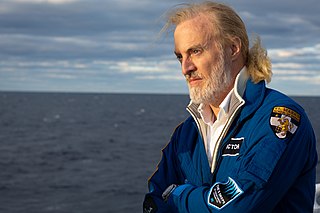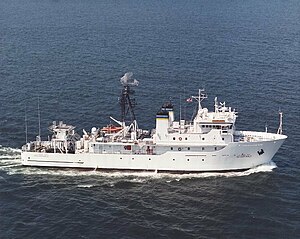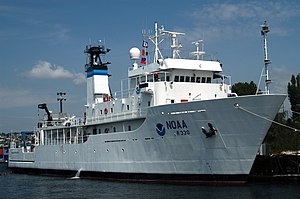
The Challenger Deep is the deepest known point of the seabed of Earth. Its depth is measured at 10,902–10,929 m (35,768–35,856 ft) by direct measurement from deep-diving submersibles, remotely operated underwater vehicles and benthic landers, and (sometimes) slightly more by sonar bathymetry.

The Mariana Trench is an oceanic trench located in the western Pacific Ocean, about 200 kilometres (124 mi) east of the Mariana Islands; it is the deepest oceanic trench on Earth. It is crescent-shaped and measures about 2,550 km (1,580 mi) in length and 69 km (43 mi) in width. The maximum known depth is 10,984 ± 25 metres at the southern end of a small slot-shaped valley in its floor known as the Challenger Deep. The deepest point of the trench is more than 2 km (1.2 mi) farther from sea level than the peak of Mount Everest.

Alvin (DSV-2) is a crewed deep-ocean research submersible owned by the United States Navy and operated by the Woods Hole Oceanographic Institution (WHOI) in Woods Hole, Massachusetts. The vehicle was built by General Mills' Electronics Group in Minneapolis, Minnesota. Named to honor the prime mover and creative inspiration for the vehicle, Allyn Vine, Alvin was commissioned on June 5, 1964. The submersible is launched from the deep submergence support vessel RV Atlantis (AGOR-25), which is also owned by the U.S. Navy and operated by WHOI. The submersible has made more than 5,000 dives, carrying two scientists and a pilot, to observe the lifeforms that must cope with super-pressures and move about in total darkness, as well as exploring the wreck of Titanic. Research conducted by Alvin has been featured in nearly 2,000 scientific papers.

Milwaukee Deep, also known as the Milwaukee Depth, is part of the Puerto Rico Trench. Together with the surrounding area, known as Brownson Deep, the Milwaukee Deep forms an elongated depression that constitutes the floor of the trench. As there is no geomorphological distinction between the two, it has been proposed that the use of both names to refer to distinct areas should be reviewed.

A deep-submergence vehicle (DSV) is a deep-diving crewed submersible that is self-propelled. Several navies operate vehicles that can be accurately described as DSVs. DSVs are commonly divided into two types: research DSVs, which are used for exploration and surveying, and DSRVs, which are intended to be used for rescuing the crew of a sunken navy submarine, clandestine (espionage) missions, or both. DSRVs are equipped with docking chambers to allow personnel ingress and egress via a manhole.

The Puerto Rico Trench is located on the boundary between the Caribbean Sea and the Atlantic Ocean. The oceanic trench, the deepest in the Atlantic, is associated with a complex transition between the Lesser Antilles subduction zone to the south and the major transform fault zone or plate boundary, which extends west between Cuba and Hispaniola through the Cayman Trough to the coast of Central America.

Trieste II(DSV-1) was the successor to Trieste – the United States Navy's first bathyscaphe purchased from its Swiss designers.
DSV-4 is a 25-ton, crewed deep-ocean research submersible owned by the United States Navy, now known only by its hull number, not by its former name.

USNS Titan (T-AGOS-15) was a Stalwart-class modified tactical auxiliary general ocean surveillance ship in service in the United States Navy from 1989 to 1993. From 1996 to 2014, she was in commission in the National Oceanic and Atmospheric Administration (NOAA) fleet as the oceanographic research ship NOAAS Ka'imimoana.
The Molloy Deep is a bathymetric feature in the Fram Strait, within the Greenland Sea east of Greenland and about 160 km west of Svalbard. It is the location of the deepest point in the Arctic Ocean. The Molloy Deep, Molloy Hole, Molloy Fracture Zone, and Molloy Ridge were named after Arthur E. Molloy, a U.S. Navy research scientist who worked in the North Atlantic, North Pacific and Arctic Oceans in the 1950s-1970s.

NOAAS McArthur, was an American survey ship in commission in the National Oceanic and Atmospheric Administration (NOAA) from 1970 to 2003. Prior to her NOAA career she was in commission in the United States Coast and Geodetic Survey from 1966 to 1970 as USC&GS McArthur (CSS-30).

Victor Lance Vescovo is an American private equity investor, retired naval officer, sub-orbital spaceflight participant, and undersea explorer. He was a co-founder and managing partner of private equity company Insight Equity Holdings from 2000-2023. Vescovo achieved the Explorers Grand Slam by reaching the North and South Poles and climbing the Seven Summits, and he then visited the deepest points of all of Earth's five oceans during the Five Deeps Expedition of 2018–2019.
Triton Submarines is a Florida-based company that designs and manufactures private submersibles for research, filming, deep-ocean exploration, and the luxury yachting and tourism sector. It was founded in 2007.

Alan J. Jamieson is a Scottish marine biologist, engineer, explorer and author, best known for his deep-sea exploration and study of life at the deepest places in the oceans. He is known for extensive use of deep-sea landers to establish the maximum depth and community dynamics of many organismal groups, as well as the discovery of many new species and highlighting the presence of anthropogenic impacts at full ocean depth. During the Five Deeps Expedition, and follow on expeditions in 2020, he completed various dives in a manned submersible to some of the deepest places in the world. He has published over 100 scientific papers and participated in 65 deep-sea expeditions.
Deo Florence L. Onda is a Filipino microbial oceanographer. He is known for being the first Filipino to descend into the Emden Deep in the Philippine Trench.

Striver bathyscaphe is a type of deep-submergence vehicle built in the People's Republic of China (PRC). It was built by China State Shipbuilding Corporation (CSSC). It can accommodate three crew members,and is designed to reach depths of more than 10,000 meters. Striver is equipped with two mechanical arms, seven underwater cameras, seven sonars, hydraulic drills, and other scientific devices.

Limiting Factor is a crewed deep-submergence vehicle (DSV) manufactured by Triton Submarines and owned and operated by Gabe Newell’s Inkfish ocean-exploration research organization. It currently holds the records for the deepest crewed dives in all five oceans. Limiting Factor was commissioned by Victor Vescovo for $37 million. It is commercially certified by DNV for dives to full ocean depth, and is operated by a pilot, with facilities for an observer.



















